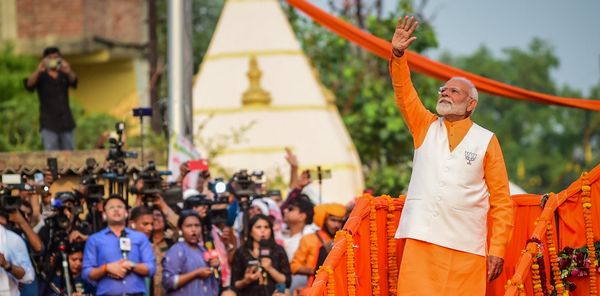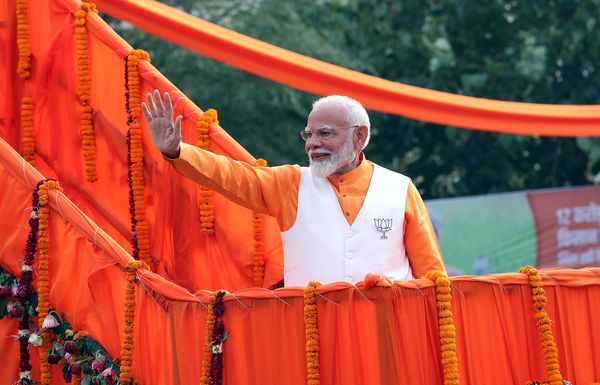
New Delhi, India – The share of Indian Muslims in the country’s population has soared by more than 43 percent since 1950: That’s the key takeaway from a new working paper published by Prime Minister Narendra Modi’s Economic Advisory Council (EAC).
Amid India’s heated national election campaign, as Modi has increasingly painted scenarios of Muslims backed by opposition parties taking over the nation’s resources, the report has sparked criticism over its timing. Sections of Modi’s ruling Bharatiya Janata Party (BJP) have amplified the findings of the paper to emphasise a narrative long peddled by the Hindu right that the community’s religious majority in the country is under threat.
So, what does the paper claim and what do the facts say? Is India’s Muslim population actually growing exponentially faster than that of other communities – including Hindus? And why is the report facing criticism?
What does the working paper say?
The report looks at global demographic trends between 1950 and 2015. It relies on statistics from the Association of Religion Data Archive (ARDA), a free online database of global religious data.
It concludes that in the period studied, the share of the Muslim population in India increased by 43.15 percent, from 9.84 percent to 14.09 percent. By contrast, it says, the share of the majority Hindu population decreased by 7.82 percent between 1950 and 2015, from 84.68 percent to 78.06 percent.
The share of India’s Christian population rose from 2.24 percent to 2.36 percent – an increase of 5.38 percent; and the Sikh population by 6.58 percent, from 1.74 percent in 1950 to 1.85 percent in 2015. The report mentions that the share of India’s Buddhist population has grown from 0.05 percent to 0.81 percent, but skips the percentage increase – nearly 1,600 percent, per this methodology – for the community.
It concludes that in most of the 167 countries studied, the population share of the majority religious faith has declined – with some in India’s neighbourhood, including Muslim-majority Pakistan, Bangladesh and Afghanistan, and Buddhist-majority Sri Lanka and Bhutan, bucking that trend.
In India’s case, the report says, the increase in the population of multiple religious minorities was a reflection of a “cumulative measure of their well-being”. The data shows, according to the paper, that in India, “minorities are not just protected but thriving” – even though multiple international reports and rankings warn of the country’s decline in religious freedom.
Yet, the paper lacks critical context, and its timing – amid the election – raises questions over its motivation, suggest some economists.
“The paper serves the purpose of the regime and not of ‘research’,” said Santosh Mehrotra, a development economist and visiting professor at the University of Bath in the United Kingdom.
Al Jazeera reached out to two co-authors of the paper, and to multiple BJP spokespersons, for their response to the criticism of the report, but they either did not respond or refused to comment.
Do these numbers lack context?
The report relies on data from a survey, not the decadal national Census that was last conducted in 2011. The 2021 census was postponed because of COVID-19, but the Modi government is yet to announce a timeline for the delayed exercise. Demographers typically consider census data more robust, as the outcome of surveys, with smaller sample sizes, can be dependent on the selection of participants.
“There is no replacement for the census – and nothing can be done for policy without this missing data,” said Aashish Gupta, a demographer and a Marie Skłodowska-Curie Fellow at the University of Oxford. “This is currently having widespread implications from allocations of funds to policy forming – none of the changes in the last 14 years in India have been accounted for.”
The paper, its critics say, overlooks the actual rise in the Hindu population in this period – and how that compares to the Muslim population increase in this period. Between 1951 and 2011, the Muslim population rose from 35.4 million to 172 million. The Hindu population rose from 303 million to 966 million in the same period – a five times greater increase.
All of that undermines the credibility of the paper, said Gupta. “This paper makes a mountain out of molehill,” he said. “It is an exercise in propaganda and politics and should not be seen as scholarly.”
Myth of Muslim population boom
India’s Hindu majoritarian right has long pushed a conspiracy theory, “population jihad”, that suggests that Indian Muslims reproduce faster, with the intent of eventually outnumbering Hindus.
In reality, however, Muslim fertility rates are falling the fastest among all major religious groups in India, according to the government’s own data. The fertility rate – the average number of children a woman gives birth to – among Muslims fell from 4.41 to 2.36 between 1992 and 2021, while it dropped from 3.3 to 1.94 for Hindus.
The report ignores this shift, said Gupta.
Critics of the new government paper say it ends up lending credibility to a debunked narrative. When politicians peddle anti-Muslim conspiracy theories, Mehrotra said, it can be passed off as dog whistles – but a “divisive paper coming under the name of EAC carries credibility”.
“This government is misutilising its resources to seed its political purposes,” said Mehrotra. “For the last 100 years, the Hindu right has been fearmongering about the Muslim population, and this paper contributes to that history without being critical.”
Why the report matters
As the re-election campaign proceeds, Modi has doubled down on his rhetoric against India’s 200 million Muslims, seemingly calling them “infiltrators” and referring to them as “those who produce more children,” though he appeared to distance himself from those comments in one subsequent interview.
The new government report offered renewed fuel for unfounded suggestions from the PM’s party that India’s Hindu majority was under threat.
Share of Hindus shrunk 7.8% between 1950 and 2015. Muslim population grew at 43%.
This is what decades of Congress rule did to us. Left to them, there would be no country for Hindus. pic.twitter.com/xNUramJyNE
— Amit Malviya (मोदी का परिवार) (@amitmalviya) May 9, 2024
Amit Malviya, in charge of the BJP national information department, cited the report to post on X that if the country were left to the opposition Congress party, “there would be no country for Hindus”. Another minister from Modi’s cabinet, Smriti Irani, said that the report was “evidence of the damage caused to Hindus” and the Congress’s legacy is of “torture and disrespect to the Hindu community”.
The new EAC paper “plays on the fears that are used to demonise India’s minority communities,” said Gupta. “In some sense, it is a strategic exercise – doing it for propaganda.”
As some sections of the Indian media amplified the conclusions of the report, the Population Foundation of India, an independent think tank, expressed concerns, accusing them of “spreading alarm regarding the growth of the Muslim population”, calling the interpretations “not only inaccurate but also misleading and baseless”.










